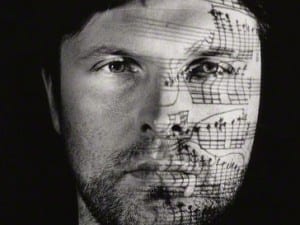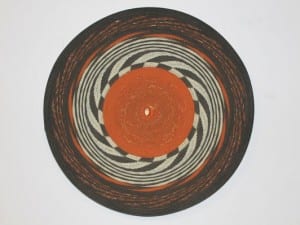The art scene in Birmingham has been given a new lease of life. Alongside the main commercial galleries there has been an abundance of lesser known exhibitions orchestrated by recent graduates and students as well as emerging artists and curators from the city. This mainly takes place in Digbeth, where studios and exhibition spaces are easily and cheaply occupied. But what happens when a gallery decides to put on an exhibition where the work only exists in a metaphysical state? Grand Union’s latest show (On) Accordance is a unique transgression between the online world and a purposefully directed gallery.
Upon entering the gallery the work largely remains isolated and detached. M+M’s Motorway-loop (1996) sees a variety of mediums used and culminates in a huge wall painting of what looks like a road sign, but is actually a sign to signal for their proposed idea of a turning circle on a motorway. Opposite, on a wall jutting out in the middle of the room and using a three-dimensional simulation, is a monitor demonstrating what this proposed road would look like in action. To the left of the monitor is a blueprint of the turning circle complete with measurements that would be used, had it ever been put into construction. This immediately conjures up the bearings of an installation, but its layout means that when the viewer is observing the blueprint and the monitor or the painting their back will be turned on the other work. This exclusion within the work might be deliberate, yet at the same time questions the way in which art is viewed within the 21st century. When viewing a work of art online the page in which the work appears allows for maximum attention on one piece, disregarding any notion of curation or spacial situation.
Immaterial (2010) by Irini Karayannopoulou, sees a variety of charcoal drawings being produced and erased in a quirky and innocent narrative. Accompanying this are 22 different sound tracks ranging from deeply abstract and sinister overtures to infant like mouth gestures. The viewer is not made aware of which one will be played, which allows for the freedom and playful invitation to revisit and investigate these sound tracks.
The hallmark of a successful exhibition is a subject that could be endlessly debated and leave audiences exiting the exhibition asking questions. How this is made apparent to the viewer is another unending answer, but one thing is for sure – when this happens one must capitalise upon it. This particular show at Grand Union is very much hidden, but reiterates itself as so painfully obvious that it could never be expected. The lifespan of the work created specifically for the show bares an unprecedented parallel to that of the lives of the viewer. In doing so the work becomes extremely personified and relatable, allowing for a sense of “friendship” or a connection to be developed.
William Davie
(On) Accordance, until 19 January, Grand Union, 19 Minerva Works,Fazeley Street, Birmingham, B5 5RS.
Credits
1. Richard Sides The Joyful System (the Usual Suspects rendition), 2012 (left); Rosa Menkman, Most Likely You Go Your Way (And I’ll Go Into the Tulgey Woods), 2011 (right).
2. Irini Karayannopoulou, Immaterial, 2010.





